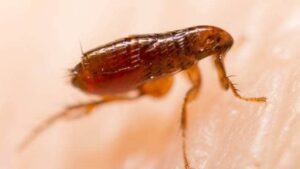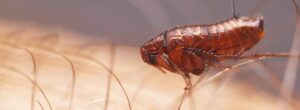Having to deal with cat or dog fleas can be truly frustrating. With how fast they procreate, fleas can be a major thorn in your side when it comes to eliminating them completely.
If this is your first time dealing with this issue, you might be frustrated at how annoying it is to control fleas, let alone get rid of them.
If you got rid of the cat, dog, or human fleas and still see immature flees around the house, you might be wondering, how long can fleas live without a host?
Because they survive in the worst environments, it takes a lot to kill fleas. Getting rid of them requires time, effort, and understanding the fleas’ life cycle. But, don’t worry because we’ll cover this topic from A to Z if you’re overwhelmed, so keep reading!
The Short Answer
Without a blood meal, fleas can live from a few days to two weeks or more. However, that depends on the life cycle of the fleas in the infested area.
It’s important to know that an infested area contains eggs, larvae, and pupae that you might not be able to see. Once the flea eggs hatch, the flea larvae feed on organic debris found on the ground. Also, fleas prefer the darker corners of infested areas, so you’ll probably find them there.
The larvae stage is followed by the pupae stage, in which the immature fleas hibernate for a pretty long while, then start their quest of searching for a new host. This can take from a few days to weeks.
In short, to eliminate adult fleas in that duration doesn’t mean you bit the problem in the bud; eggs, larvae, and pupae might still be there, and they’re as great a risk as their adult flea counterpart. They’ll still pop around the house, and the life cycle of fleas will get repeated if you don’t have a proper flea control method.
So, how can you eliminate surviving fleas and minimize that period? First, you’ll need to understand the life cycle fleas pass by basics. So, let’s get into that.
Flea Life Cycle
Let’s lay the groundwork for how the flea’s life cycle goes. If flea eggs hatch, and there’s a host that’ll provide the flea pupae with their first blood meal, any type of fleas (including cat fleas, dog fleas, rat fleas, and human fleas) will continue to infest the area.
Without any flea control involved, adult fleas live up to a year, provided that their proper host is present and the infested areas are of moderate living temperatures.
Here’s how the cycle starts:
Flea Eggs
Female fleas start the cycle as they lay flea eggs right after getting a blood meal from the host (that includes adult cat fleas or dog fleas). A female flea will lay eggs on your pet fur, and as your pet moves around, the flea eggs will naturally fall around the area where your pet spends its time the most.
Flea eggs will remain dormant if environmental conditions aren’t right and will hatch when they are, which can be inconvenient and tricky for pet owners to a great extent. This process might take from 2 days to 2 weeks.
After the flea eggs hatch, larvae will come out of the eggs and continue infesting the same area in their new form.
Survival Period
If flea eggs don’t hatch within 2 weeks, they probably won’t hatch at all.
Flea Larvae
Flea larvae are blind, so they’ll often resort to dark, dry places, and this is where you should be looking for them.
As for their diet, it’s composed of organic debris found around the flea infestation area. Unlike adult fleas, flea larvae feed on a pre-digested blood meal (which makes the second part of their diet).
There’s nothing special about flea larvae and this stage except that they’re incredibly resilient to the point that they can go without their first blood meal for 100 days or more.
Survival Period
Flea larvae are resilient, but they won’t survive if conditions aren’t suitable. They can only survive up to only 45 days.
Flea Pupae
Flea pupae make up about 10% of any flea infestation, and this is the last developmental stage before the adult fleas emerge out of their cocoon. A cocoon protects the pupae from several days to weeks in a flea life cycle. However, this duration can extend up to months. It all depends on the environmental conditions.
Unlike flea eggs, flea cocoons are hard to get rid of. Due to the sticky outer layer of these cocoons, you can’t get rid of them using the traditional methods to eliminate fleas, such as insect growth regulators, flea combs, or flea collars.
The sticky outer layer protects the pupae from chemicals, so it’s very tricky to clean out the flea breeding sites at this point. Because these immature fleas can’t live without a host, the pupae will wait for the right moment by sensing vibrations, heat, or high levels of carbon dioxide.
Survival Period
The most difficult stage of a flea life cycle is notoriously known; pupae can survive up to 5 months in poor conditions.
Adult Fleas
Newly emerging fleas can’t live without a host, so they’ll look for furry mammals to find their new living ground. Therefore, be sure to inspect your pet fur regularly if you have one, as this is the best flea life cycle stage to locate and eliminate fleas easily.
A new adult flea looks small and has a darker color, but once the flea feeds off your pet, it’ll become lighter. If you’re not so sure if you have flea infestations, you can inspect your pet for adult flea excrement (red spots that indicate flea bites) or hair loss. Other than that, it’ll be fairly easy to spot adult fleas due to their color.
Adult fleas feed on a host’s blood, which is most probably your pet. Additionally, adult fleas make up 5% of the flea population in the infested area, and you’ll often find them residing in furry mammals distributing flea feces. It’s also the optimal location for female fleas to lay eggs.
Survival Period
Adult fleas can live anywhere from a couple of weeks to several months. However, a female flea only lives for up to 24 hours when separated from its host without a host.
On the other hand, adult fleas’ survival hangs on their blood dependency on the blood source and environmental conditions. This can take from 2 to 4 days.
Younger adult fleas feed less frequently than fully adult fleas; however, they survive longer than fully adult fleas as there’s no blood dependency factor to affect their survival. Immature fleas live up to two weeks.
Infestation Control
This is a serious health hazard whether you have cat fleas, dog fleas, or human fleas. Kids can very well ingest fleas by accident, which, in turn, will transmit an assortment of diseases to them, so you’ll need to control fleas at all costs. Here are some surefire methods to help you kill fleas immediately.
1. Treat Your Pet
If you think you have a flea infestation in your house, the first type of fleas you should consider is the cat flea (or pet flea in general). You might see your cats constantly scratch if they have cat fleas. You might also find some fallen cat fleas on pet beds.
Luckily, treating cat flea is much easier than treating human flea, as you’ll only need to apply treatments to your pet, have them wear flea collars, and comb their fur with a flea comb for good measure. You might also want to change pet bedding regularly (especially infested pet bedding) and treat all pet loafing areas by vacuuming to ensure that fleas are fully eliminated.
Using soap on pet bedding is also an excellent idea, as it helps control light infestations.
In contrast, dog fleas are quite resilient. Therefore, stronger flea control methods are in order if dogs’ fleas survive sanitizing pet beds and flea comb treatments.
Using flea and tick shampoo or prescription treatments against fleas is also a great idea to deal with recurring flea infestations, but be sure to consult a vet first on the products you’ll use.
2. Treat the Infested Area
Vacuuming is your best friend throughout any flea infestation period as it’ll rid you of 30% of flea larvae as well as 60% of flea eggs, so make sure that you vacuum carpets cushions, beds, furniture, and walls.
You might also want to use insect growth regulators along with a mild insecticide. While insect growth regulators won’t allow flea eggs to hatch and disrupt the development of flea larvae, it won’t affect the adult fleas’ development, so using an insecticide is a must.
If fleas survive insect growth regulators, you’ll need an integrated flea control program to help you to eliminate adult fleas quickly. An integrated flea control program might include imidacloprid, which is a great method that kills adult fleas quickly. It can also include borates, a chemical that kills immature fleas effectively.
Tip: While these chemicals contain very low toxicity levels, they still can pose a slight hazard, so always use them with caution.
3. Pest Control Help
Finding the perfect method that kills adult fleas isn’t that easy; you need an excellent pest control method to eliminate fleas in all stages to get rid of them once and for all. A pest control company can help with that.
A professional pest control company might also send experts to recommend certain treatments that you can apply on your own, like effective insect growth regulators, flea traps, and so on. They might also tell you the exact location where you have a flea infestation.
Pro-Tip
If you’re using chemical treatments, vacuuming, using insect growth regulators, or simply applying homemade anti-flea treatments, make sure you’re wearing protective clothing to avoid painful flea bites. Your clothes should be thoroughly cleaned as well after you’re done to avoid having fleas infesting your wardrobe.
Bottom Line
Now that you know how long can fleas live without a host, you better understand how long fleas (depending on which flea life cycle they’re at) can live. This should also give you an idea of which better flea treatment to use.
Do consider the preemptive methods we mentioned here, especially treating your pet since this is the prime reason people get a flea infestation on most occasions. It’d be best if you also considered wearing longer clothes to avoid painful flea bites.



